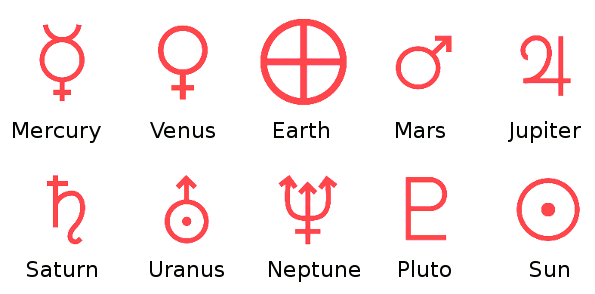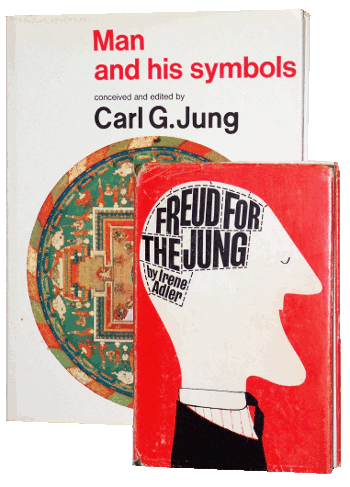Man and His Symbols
May 4, 2012
In a
recent article (Fire, April 20, 2012), I wrote about the important role that
written language has had in the development of our
technological society. Writing is a very effective means of
information diffusion, since ideas can travel in time as well as in distance.
As an example of the ubiquity of writing, look around the place where you are now. Even if you ignore these
characters on your
display, you're buried in
script. The interesting thing is that we don't really notice the letters and words as objects, themselves. We just read the message and forget the
medium. Having written
that, how can I not mention the
famous book of
my generation,[1] so nicely explicated in the
Woody Allen movie,
Annie Hall.[2]

Ancient symbols for solar system objects. Nowadays, Pluto might need to be written in lower case. (Via Wikimedia Commons))
I don't remember learning how to read, but the early stages must have been a chore, both for me and my teachers. What I do remember is that, after learning to read, I started to read almost everything available, which amounted to the
Sunday comics,
cereal boxes, and
Life magazine. With access to the
public library, my reading progressed
exponentially, since I could read any topic I wished.
There was, however, some
chaff mixed with the
wheat. These were the tedious books assigned by
English teachers. One of these, which should have been assigned only as a punishment, was
Johnny Tremain. It won the 1944
award for best children's book, presumably because of its mix of
patriotism and life lessons, but it wasn't my type of book.
Now, the library has been replaced by the
Internet, and my
Webster's Second Edition has been replaced by a spell-checker. I never did like
Webster's Third Edition, since it dropped too many older words. This was a nuisance in the pre-Internet days, when you were reading older books, whereas the second edition was perfectly
cromulent in that regard. My beloved
Encyclopaedia Britannica has been replaced by
Wikipedia, for which I've contributed articles.
A recent study by
educators at
Ohio State University, the
University of Virginia, and the
University of Toledo has determined that what's been lacking in the teaching of reading is a greater awareness of the letters, the symbols, themselves.[3-4] Reading teachers are most effective when they point out letters and words in text, show
capital letters, and explain often the principle that you read from left to right, and top to bottom.
The study, conducted in a reading program entitled,
Project Sit Together and Read (STAR), involved 550 four-year-olds in low-income
neighborhoods in a thirty-week shared-book reading program in 85 targeted-enrollment preschool classrooms serving low-income children. Such a
cohort of children is traditionally at risk for developing reading problems later in school.[3]
As could be expected in such a study, a
control group was read books in a traditional style that doesn't draw attention to the letters on the page. In the other student group, teachers talked about the printed words, pointed out some of the words and letters, and did things such as trace letters with their fingers. The teachers asked whether children knew certain letters, and they mapped printed words to the spoken words.[3] An earlier study showed that untrained teachers reference print only a quarter of the time as trained reading teachers.[4]
Children who were read to in this way that referenced the symbols on the page and their arrangement showed better reading comprehension and better spelling skills when assessed one, and two years later. Also, students who were read to more often in the symbol-focused group had better scores.[3] The proposed mechanism for such improvement is that children need to associate the symbols with how they relate to words.[4]
Said team member,
Shayne B. Piasta,
assistant professor of teaching and learning and assistant director of the
Children's Learning Research Collaborative at Ohio State University,
"By showing them what a letter is and what a letter means, and what a word is and what a word means, we're helping them to crack the code of language and understand how to read."[4]
Laura Justice, professor of teaching and learning at Ohio State was the
principal investigator for this study, which was supported by the
U.S. Department of Education. The other team members were Piasta,
Anita McGinty of the University of Virginia, and
Joan Kaderavek of the University of Toledo. The team has published these results in the April 2012 issue of the journal,
Child Development.[5]
The title of this article comes from
Carl Jung's book,
Man and His Symbols. I have that book on my bookshelf, alongside the entertaining book, "Freud for the Jung, or Three Hundred and Sixty Six Hours on the Couch," by Irene Adler.[6]

From the author's bookshelf.
Man and his symbols was Karl Jung's last major work. It's a light review of Jung's ideas that includes his theory of archetypes.
Adler's book, published in 1963, is a humorous novel about psychoanalysis. As for the book's title, Jung and Freud were founders of psychoanalysis, albeit with different emphasis.
Irene Adler was the pseudonym for Catherine Storr, a prolific author of children's books and a psychiatrist, herself)
![]()
References:
- Marshall McLuhan, "Understanding Media: The Extensions of Man," McGraw-Hill, 1964, 318 pp., ISBN 8114675357.
- Scene from Woody Allen's "Annie Hall" (1977), YouTube Video; a shorter version can be found, here.
- Sarah Hutcheon, "Early focus on print promotes later literacy achievement," Society for Research in Child Development Press Release, April 17, 2012.
- Preschoolers' reading skills benefit from 1 modest change by teachers, Ohio State University Press Release, April 17, 2012.
- S.B. Piasta, L.M. Justice, A.S. McGinty and J.N. Kaderavek, "Increasing Young Children's Contact With Print During Shared Reading: Longitudinal Effects on Literacy Achievement," Child Development, April, 2012, doi: 10.1111/j.1467-8624.2012.01754.x.
- Irene Adler, "Freud For the Jung Or Three Hundred and Sixty Six Hours on the Couch," Cresset Press, 1963, 170 pp. (via Amazon).
Permanent Link to this article
Linked Keywords: Written language; technology; technological; information diffusion; alphabet; character; display; writing system; script; medium; The medium is the message; Understanding Media: The Extensions of Man; baby boomer; Woody Allen; film; movie; Annie Hall; astronomical symbols; ancient symbols for solar system objects; Pluto; letter case; lower case; Wikimedia Commons; Sunday comics; cereal box; Life magazine; public library; exponential function; chaff; wheat; English; teacher; Johnny Tremain; Newbery Medal; award for best children's book; patriotism; Internet; Webster's Second Edition; Webster's Third Edition; cromulent; Encyclopaedia Britannica; Wikipedia; educator; Ohio State University; University of Virginia; University of Toledo; capital letter; Project Sit Together and Read; neighborhood; cohort; control group; Shayne B. Piasta; assistant professor; Children's Learning Research Collaborative; Laura Justice; principal investigator; U.S. Department of Education; Anita McGinty; Joan Kaderavek; Society for Research in Child Development; Child Development; Carl Jung; Man and His Symbols; archetype; psychoanalysis; Freud; Irene Adler; Catherine Storr; psychiatrist.